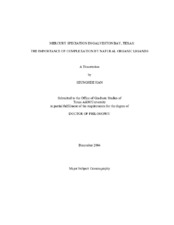| dc.contributor.advisor | Gill, Gary A. | |
| dc.creator | Han, Seunghee | |
| dc.date.accessioned | 2005-02-17T21:04:41Z | |
| dc.date.available | 2005-02-17T21:04:41Z | |
| dc.date.created | 2004-12 | |
| dc.date.issued | 2005-02-17 | |
| dc.identifier.uri | https://hdl.handle.net/1969.1/1539 | |
| dc.description.abstract | The major goal of this research is the development of a competitive ligand
equilibration-solvent solvent extraction (CLE-SSE) method to determine organically
complexed mercury species in estuarine water. The method was applied to estuarine
surface waters of Galveston Bay and the water column of Offatts Bayou.
Thermodynamic equilibrium modeling estimated organically complexed mercury
species in estuarine water using the conditional stability constants of mercury-organic
complexes and the concentrations of organic ligands determined by CLE-SSE.
Two competing ligands, chloride and thiosalicylic acid (TSA), were used for
CLE-SSE. Chloride ion competition determined conditional stability constants for 1 : 1
mercury-ligand complexes ranging from ~1023 to ~1024 with concentrations of organic
ligands at low nM levels. TSA competition determined stronger mercury-binding ligands
by manipulating the TSA concentration such that a higher binding strength was achieved
than that for the mercury-chloride complex. TSA competition determined conditional
stability constants for 1 : 1 mercury-ligand complexes ranging from ~1027 to ~1029, with
ligand concentrations ranging from 10 to 100 pM. Mercury-organic binding strengths in
these ranges are consistent with bidentate mercury complexation by low molecular
weight organic thiols. A linear relationship was observed between log stability constants
for the mercury-ligand complex and log ligand concentrations, supporting the hypothesis
that there is a continuum of mercury binding site strengths associated with dissolved
organic matter.
In Galveston Bay, organically complexed mercury accounted for > 95 % of the
total dissolved mercury in surface water. Organic complexation of mercury coupled with
mercury dissolution from particulate phases controls the filter-passing mercury
distribution in surface waters of Galveston Bay. The estuarine distributional features of
mercury-complexing organic ligands were similar to those of glutathione, supporting
mercury complexation by a thiol binding group. In Offatts Bayou, a seasonally anoxic
bayou on Galveston Bay, thermodynamic equilibrium modeling suggests that the
speciation of dissolved mercury in anoxic systems is dominated by sulfide complexation
rather than organic complexation. | en |
| dc.format.extent | 648173 bytes | en |
| dc.format.medium | electronic | en |
| dc.format.mimetype | application/pdf | |
| dc.language.iso | en_US | |
| dc.publisher | Texas A&M University | |
| dc.subject | mercury | en |
| dc.subject | organic | en |
| dc.subject | estuary | en |
| dc.subject | speciation | en |
| dc.title | Mercury speciation in Galveston Bay, Texas: the importance of complexation by natural organic ligands | en |
| dc.type | Book | en |
| dc.type | Thesis | en |
| thesis.degree.department | Oceanography | en |
| thesis.degree.discipline | Oceanography | en |
| thesis.degree.grantor | Texas A&M University | en |
| thesis.degree.name | Doctor of Philosophy | en |
| thesis.degree.level | Doctoral | en |
| dc.contributor.committeeMember | Cifuentes, Luis A. | |
| dc.contributor.committeeMember | Lindahl, Paul A. | |
| dc.contributor.committeeMember | Santschi, Peter H. | |
| dc.type.genre | Electronic Dissertation | en |
| dc.type.material | text | en |
| dc.format.digitalOrigin | born digital | en |


